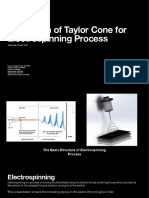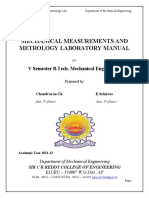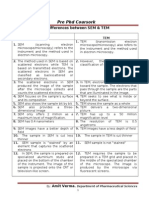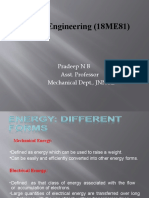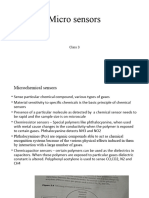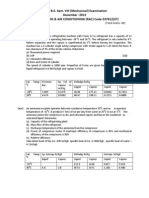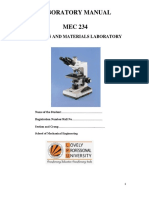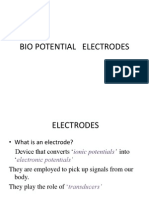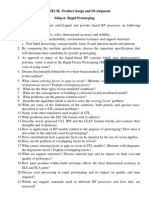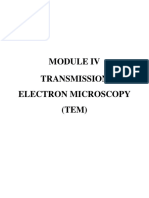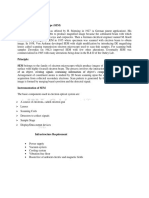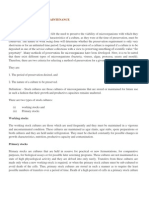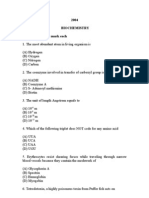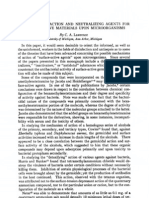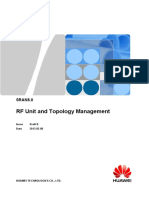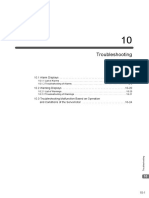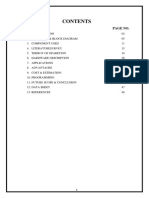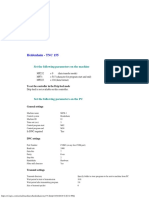Lecture Notes - Electron Micros
Lecture Notes - Electron Micros
Uploaded by
Suresh MgCopyright:
Available Formats
Lecture Notes - Electron Micros
Lecture Notes - Electron Micros
Uploaded by
Suresh MgOriginal Description:
Original Title
Copyright
Available Formats
Share this document
Did you find this document useful?
Is this content inappropriate?
Copyright:
Available Formats
Lecture Notes - Electron Micros
Lecture Notes - Electron Micros
Uploaded by
Suresh MgCopyright:
Available Formats
P Finkel
MATE 515
ELECTRON MICROSCOPY Transmission Electron Microscope (TEM) versus Transmission Optical Microscope (TOM) TEM 100-400 kV electron gun high current densities: 5 x 104 Am-2 for tungsten filament 1 x 106 Am-2 for field-emission source Condenser lens Electromagnetic lens, focus adjusted by controlling the lens current Specimen stage Allows for specimen tilt as well as some z-adjustment Objective lens Fine focusing of the image by adjusting the lens current Source Final imaging system Recording system Experimental set-up in Employs electromagnetic lenses to produce image on a fluorescent screen Computer monitor or TV Vacuum, better than 10-6 torr TOM Light source
Glass lens, focus adjusted by lens position Allows for specimen tilt as well as some z-adjustment Fine focusing by adjusting the position of the specimen and the objective lens Eye piece forming image for direct viewing Normal viewing or photographic films Air, at atmospheric pressure
60
P Finkel
MATE 515
Scanning Electron Microscopy (SEM)
61
P Finkel
MATE 515
Major components are the electron column consisting of an electron gun and the electron lenses, and the control console consisting of a cathode ray tube viewing screen and the scanning and control electronics for the electron beam. The three dimensional appearance of the image is due to the large depth of field. A scanning electron microscope (SEM) employs a probe lens to focus the electron beam into a fine probe and scanning coils are used to scan the probe over the sample.
62
P Finkel
MATE 515
Resolution of the SEM is controlled by the probe lens. It is the inelastically scattered electrons that provide information. Usually < 30 keV electrons are used in SEM. In optical microscopy and TEM, information is collected continuously over the full field of view (from all image points simultaneously) and focused by suitable lenses to form a magnified image. In SEM, information is collected sequentially.
Electron Sources:
The filament is resistively heated to 2000 2700K by applying a high voltage and a small amount of current to a point that valence electrons are released from its tip in what is called a space charge cloud. The amount of energy needed to cause electrons to leave the filament is called the work function. The electrons are released in all directions. The potential (charge) - or excess of electrons - to create electrons and control their emission. Wehnelt cap/grid has a slight negative negative lines of force that focus the emitted
63
P Finkel
MATE 515
The filament or cathode is supplied with a high negative voltage, e.g. -20,000 volts. The anode, a metal plate with a hole in it, is at ground potential (0 volts) and is greatly positive with respect to the cathode. This potential difference accelerates the electrons toward the anode.
Along the route from the cathode to the anode, the paths of the individual electrons cross each other. This is called the point of crossover with diameter d0. It is considered the real source in the electron gun, and its image is projected onto the specimen surface. After the crossover, the electron beam diverges with a divergence angle 0. The condenser and objective lenses then produce a demagnified image of the crossover on the specimen with an image diameter dp.
64
P Finkel
MATE 515
The anode has a hole in it. This hole allows only a fraction of the electrons to continue down the column toward the lenses. The remaining electrons are collected on the anode and returned via the ground to the voltage supply. Hot Cathode Guns: Tungsten filaments and Lab-six LaB6 crystals, producing thermionic emission of electrons. Thermionic emission formula: Current density I = AT2 exp(-E/kT) A = Richardsons constant depending on the source material, T = emission temperature K (C+273), E = work function or the energy required to escape from the filament into the vacuum, k = Boltzmans constant.
Tungsten: stable beam current short life large tip large emitting area (probe diameter) low brightness high work function high evaporation rate lower vacuum (10-6 Torr) low resolution 2700 K
LaB6: stable beam current 10 times longer life smaller tip smaller emitting area (probe diameter) higher brightness (10 times higher current) lower work function medium evaporation rate higher vacuum (10-7 Torr) higher resolution (due to thinner beam) 1700 K
65
P Finkel
MATE 515
Field Emission: This is based on the fact that electrons can be drawn off from a material by applying a high voltage in ultra high vacuum conditions. stable beam current if heated, unstable if cold very long life more monochromatic small tip very small emitting area (small probe diameter) very high brightness (1000 times compared to hot guns) concentrated electric field can tunnel through energy barrier low evaporation rate very high vacuum (10-10 Torr) very high resolution (electrons are emitted from a very fine tip) three types cold, thermal, Schottky
Electron Beam The electrons that go through the hole in the anode and continue down the column to the specimen make up the electron beam. The flow of these electrons in called the beam current. The electron beam is manipulated by lenses and apertures.
Electromagnetic lenses and focusing:
66
P Finkel
MATE 515
Since electrons have a charge, their direction of travel can be altered by an electromagnetic field. An electron traveling in offaxis to a uniform magnetic field follows a helical path. Electrons can be brought to focus by engineering the electrostatic and/or magnetic fields. In the region of electron gun, the beam is influenced by the electrostatic field. All the subsequent focusing is achieved by electromagnetic lenses.
The condenser lens concentrates (or demagnifies) the beam of electrons into a small area called a spot. It is like the condenser on an optical transmission microscope which concentrates light from the light source (e.g,. a light bulb) into a small area as it passes through the specimen slide. The size of the spot can be adjusted. It can be a large area or it can be adjusted to be a small area. Condenser or spot size control is one of the most important controls on an SEM.
In the electromagnetic lens, the intensity of the field (the magnetic flux) causes a radial vector along the optical axis, so when an electron is accelerated through the pole pieces, it takes a helical path through the lens. The rotational force is the product of the electron velocity and the density of the magnetic flux. This vector interaction also results in focusing as the strength of the lens is changed.
67
P Finkel
MATE 515
Focal length of the electromagnetic lens is controlled by varying the lens current. The focal length is approximately proportional to V/(NI)2 where V is the accelerating voltage, N is the number of turns in the magnet coil and I is the current.
68
P Finkel
MATE 515
Electron lenses demagnify the image of the beam crossover (with d0 ~ 50m for a heated electron gun) in the electron gun to the final spot size on the specimen of ~10 nm. This represents a demagnification by 5000 times. These lenses are created with high precision and even a hairline scratch can distort their magnetic field and will have to be replaced. Most electromagnetic lenses are cooled with water to prevent extra heating. Their functions are similar to optical lenses. A condenser lens can condense electrons; an objective lens can focus electrons on the specimen, and a projector lens can project an image onto a screen.
69
P Finkel
MATE 515
1/f = 1/p + 1/q Demagnification m = p/q = d0/d1
Like in optical microscopy, spherical aberration makes peripheral electrons to be deflected more than electrons that are closer to the center. Electrons in the beam with slightly different velocities or wavelengths causes chromatic aberration. Both types of aberrations results in a disk rather than a point where all the rays converge. Both types of aberrations make the image blurred and reduce resolution. Diameter of the disk ds in the case of spherical aberration ds = Cs3 Where Cs is the spherical aberration coefficient (usually few millimeters) directly related to the accelerating voltage and the focal length of the lens and is the aperture angle.
Diameter of the disk in the case of chromatic aberration dc = E/E Cc WhereE/E is the fractional variation in electron beam voltage, Cc is the chromatic aberration coefficient related to the focal length of the lens and is the aperture angle.
70
P Finkel
MATE 515
71
P Finkel
MATE 515
Increasing the working distance produces a larger spot size at the specimen and a consequent degradation of the image resolution. Increasing the condenser lens strength increases the demagnification of each lens by reducing the probe size dp.
Neglecting chromatic aberration, the dependence of probe size dp on probe current ip can be written as:
72
P Finkel
MATE 515
where constant K ~ 1. The value of dp can be obtained in nm when Cs and are in nm, ip in Amperes and brightness in A/cm2 sr.
73
P Finkel
MATE 515
Depending on the type of electron source, and its inherent brightness, the focused beams can have sizes ranging from nanometers to micrometers carrying currents ranging from picoamperes to microamperes. The thermionic guns have a minimum probe size of ~ 10 nm. Field emission guns have the smallest probe diameters ~ 1.2 nm suitable for higher resolution SEM measurements.
Resolution can be improved by increasing the accelerating voltage. But one has to worry about radiation damage at such high voltages. The lenses in a SEM are generally electromagnets, coils of copper wire around a hollow iron core through which the electrons pass as they are accelerated down the column. By applying a direct current through the copper coil, we can create a magnetic field in the hollow of the lens that will slightly change the path of the electron beam, and we can control that path by varying the current in the coil, which in turn changes the strength of the electromagnetic field.
The electromagnetic lens is a notoriously poor lens when compared to the glass lens that focuses light. Some aberrations cannot be corrected as they can in glass lenses.
*********************************************
74
P Finkel
MATE 515
75
You might also like
- 1000 MCQ Bank QuestionsDocument157 pages1000 MCQ Bank Questionsapi-2629165193% (61)
- Chapter 1: Introduction To Materials Science & Engineering What Is Materials Science & Engineering?Document6 pagesChapter 1: Introduction To Materials Science & Engineering What Is Materials Science & Engineering?Aruzhan100% (1)
- Plano Electrico m313c 2Document4 pagesPlano Electrico m313c 2Krippy Kush100% (1)
- On ElectrospinningDocument27 pagesOn ElectrospinningV ArvindNo ratings yet
- JOining ProcessDocument16 pagesJOining Processarun t nNo ratings yet
- Chap 3 DieterDocument25 pagesChap 3 DieterTumelo InnocentNo ratings yet
- Composite Materials NewDocument74 pagesComposite Materials NewSns ImunNo ratings yet
- Micro Electronic Mechanical Systems (MEMS)Document3 pagesMicro Electronic Mechanical Systems (MEMS)Aditya Narayan SahooNo ratings yet
- UNIT I and II - ESSAY AND SHORT QUESTIONS PDFDocument8 pagesUNIT I and II - ESSAY AND SHORT QUESTIONS PDFSãkëth RèddièNo ratings yet
- Lecture 10 - Recovery Recrystallication and Grain GrowthDocument22 pagesLecture 10 - Recovery Recrystallication and Grain GrowthsimNo ratings yet
- Principles of Casting Technology: Mechanical EngineeringDocument1 pagePrinciples of Casting Technology: Mechanical Engineeringrotimi olalekan fataiNo ratings yet
- Types of Methods of Powder Production:: Physico Chemical Processes Are As UnderDocument11 pagesTypes of Methods of Powder Production:: Physico Chemical Processes Are As UnderDevashish JoshiNo ratings yet
- X20818 (Me6008 Ptme6008)Document3 pagesX20818 (Me6008 Ptme6008)saranNo ratings yet
- Lecture 31 PDFDocument4 pagesLecture 31 PDFBhavesh Dilip ChanchlaniNo ratings yet
- MS-II Lab ManualDocument18 pagesMS-II Lab ManualdibyenindusNo ratings yet
- ME8491 Engineering Metallurgy COURSE PLANDocument4 pagesME8491 Engineering Metallurgy COURSE PLANKarthick NNo ratings yet
- Electro Jet DrillingDocument17 pagesElectro Jet DrillingKaustubh JoshiNo ratings yet
- MM&M LAB STUDENT MANUAL Front PagesDocument6 pagesMM&M LAB STUDENT MANUAL Front Pageschandrarao chNo ratings yet
- Differences Between SEMDocument1 pageDifferences Between SEMprinceamitNo ratings yet
- High Frequency Resistance WeldingDocument23 pagesHigh Frequency Resistance WeldingAnonymous cgcKzFtXNo ratings yet
- Energy Engineering (18ME81) : Pradeep N B Asst. Professor Mechanical Dept., JNNCEDocument50 pagesEnergy Engineering (18ME81) : Pradeep N B Asst. Professor Mechanical Dept., JNNCEPradeep N BNo ratings yet
- Sine Bar Mechanical MeasurementsDocument6 pagesSine Bar Mechanical MeasurementsNenu Na RakshasiNo ratings yet
- Me Lab1 Group3Document20 pagesMe Lab1 Group3DECIPOLO, KENNETH JOHN E.No ratings yet
- Micro Sensors Class3Document18 pagesMicro Sensors Class3Anupriya T MNo ratings yet
- Exp.3 Specimen PreparationDocument9 pagesExp.3 Specimen PreparationG. Dancer GhNo ratings yet
- Updated 3rd Sem Syllabus (JUT) PDFDocument92 pagesUpdated 3rd Sem Syllabus (JUT) PDFRounak GuptaNo ratings yet
- JNTUK - B Tech - 2018 - 4 1 - Mar - R16 R13 R10 - MECH - RT41037022018 MATERIAL CHARACTERIZATION TECHNIQUESDocument1 pageJNTUK - B Tech - 2018 - 4 1 - Mar - R16 R13 R10 - MECH - RT41037022018 MATERIAL CHARACTERIZATION TECHNIQUESConor StevensonNo ratings yet
- Metallurgy and Material Science - Module 1Document36 pagesMetallurgy and Material Science - Module 1Devasivan Csr100% (1)
- Question Paper For RACDocument2 pagesQuestion Paper For RACSDvidyaNo ratings yet
- Topic 3Document17 pagesTopic 3Ramli karamNo ratings yet
- ThermoelectricDocument21 pagesThermoelectricanupam kumarNo ratings yet
- Unit 2 CONVENTIONAL ENERGY UpdatedDocument96 pagesUnit 2 CONVENTIONAL ENERGY UpdatedSOWMI C SNo ratings yet
- Engineering Drawing Exercise 4Document3 pagesEngineering Drawing Exercise 4Charlee EdsonNo ratings yet
- ME8792 2marksDocument31 pagesME8792 2marksRajNo ratings yet
- Laser Surface ModificationDocument18 pagesLaser Surface ModificationHomayra Tabassum100% (1)
- Lecture Notes Chapter 4 PDFDocument50 pagesLecture Notes Chapter 4 PDFHui ShanNo ratings yet
- Metal Powder Processing TechniquesDocument26 pagesMetal Powder Processing TechniquesAzhar Ali0% (1)
- 3d ScanningDocument15 pages3d ScanningNitin JaidNo ratings yet
- Wire Tube DrawingDocument48 pagesWire Tube DrawingSarthak JadhavNo ratings yet
- Introduction To Non Conventional OperationsDocument13 pagesIntroduction To Non Conventional Operationssham javed100% (1)
- Induction Hardening (Bayu-Bowo)Document22 pagesInduction Hardening (Bayu-Bowo)zaid sulaimanNo ratings yet
- Mf5103 Advances in Casting and Welding: For Syllabus, Question Papers, Notes & Many MoreDocument2 pagesMf5103 Advances in Casting and Welding: For Syllabus, Question Papers, Notes & Many MoreNandha Gopal SenthilnathanNo ratings yet
- Float Zone & Bridgman Crystal Growth Techniques: Abu Syed Md. Jannatul Islam Lecturer, Dept. of EEE, KUET, BDDocument27 pagesFloat Zone & Bridgman Crystal Growth Techniques: Abu Syed Md. Jannatul Islam Lecturer, Dept. of EEE, KUET, BDBomkesh SardarNo ratings yet
- Characteristics of St.37 Steel Materials With Temperature and Time On Heat Treatment Test Using FurnaceDocument5 pagesCharacteristics of St.37 Steel Materials With Temperature and Time On Heat Treatment Test Using FurnaceInternational Journal of Innovative Science and Research TechnologyNo ratings yet
- Lab Manual Mec 234Document48 pagesLab Manual Mec 234hemanth singhNo ratings yet
- The Lever Rule PDFDocument4 pagesThe Lever Rule PDFMathaneshan RajagopalNo ratings yet
- Lecture 1Document11 pagesLecture 1Ammar AltafNo ratings yet
- LECTURE 15-1: Synthesis and Preparation of Nanomaterials (Crystalline and Thinfilm)Document30 pagesLECTURE 15-1: Synthesis and Preparation of Nanomaterials (Crystalline and Thinfilm)Sk. Laila AyeshaNo ratings yet
- Recent Trends in Non-Traditional Machining Processes: Unit - 5Document12 pagesRecent Trends in Non-Traditional Machining Processes: Unit - 5DISHA VNo ratings yet
- Physics Lab ManualDocument48 pagesPhysics Lab ManualHimanshu UpadhyayNo ratings yet
- Chapter 4 - Atomic StructureDocument30 pagesChapter 4 - Atomic StructureAmrit NumanNo ratings yet
- Smart Materials and Structures: Answer Any Fivefull QuestionsDocument1 pageSmart Materials and Structures: Answer Any Fivefull QuestionsRavi TejNo ratings yet
- Bio ElectrodesDocument26 pagesBio ElectrodesSharok Nancy JoshuvaNo ratings yet
- ME 111 Mechanical Engineering Orientation: Engr. Khesiya Mae C. ManlangitDocument11 pagesME 111 Mechanical Engineering Orientation: Engr. Khesiya Mae C. ManlangitPink NoodlesNo ratings yet
- Biocomposite Material For Biomedical ApplicationDocument23 pagesBiocomposite Material For Biomedical ApplicationRehan SharmaNo ratings yet
- Meta Lab ManualDocument66 pagesMeta Lab Manualharshal wasnik100% (1)
- Solidification ShrinkageDocument16 pagesSolidification ShrinkageSherif El-soudyNo ratings yet
- Additive MFG Question BankDocument4 pagesAdditive MFG Question BankPravinNo ratings yet
- Unit 1-Complete Notes With MCQDocument73 pagesUnit 1-Complete Notes With MCQshriman100% (1)
- IE334 Quality Control & Non Destructive Testing LabDocument2 pagesIE334 Quality Control & Non Destructive Testing LabloshidhNo ratings yet
- Phy (H) Vi Nano Material 11 AjaypratapDocument15 pagesPhy (H) Vi Nano Material 11 AjayprataptadilakshmikiranNo ratings yet
- Phy (H) Vi Nano - Material 14 AjaypratapDocument12 pagesPhy (H) Vi Nano - Material 14 AjaypratapAnwesh AnshumanNo ratings yet
- Read The Newspaper Lately?: BIO 304 MicrobiologyDocument18 pagesRead The Newspaper Lately?: BIO 304 MicrobiologySuresh MgNo ratings yet
- Rdna TechnologyDocument22 pagesRdna TechnologySuresh MgNo ratings yet
- Microscope Cleaning ProcedureDocument1 pageMicroscope Cleaning ProcedureSuresh MgNo ratings yet
- Gopal - Preservation Techniques of MicroorganismDocument14 pagesGopal - Preservation Techniques of MicroorganismSuresh MgNo ratings yet
- Stock Culture and Its MaintenanceDocument4 pagesStock Culture and Its MaintenanceSuresh Mg100% (2)
- Paper-Iii Environmental Sciences: Signature and Name of InvigilatorDocument32 pagesPaper-Iii Environmental Sciences: Signature and Name of InvigilatorSuresh MgNo ratings yet
- LF 2 Algae Its Role Species and Production RequirementsDocument23 pagesLF 2 Algae Its Role Species and Production RequirementsSuresh MgNo ratings yet
- Exam1 CsirDocument6 pagesExam1 CsirSuresh MgNo ratings yet
- 2004 Biochemistry Q.1 - 10 Carry One Mark EachDocument18 pages2004 Biochemistry Q.1 - 10 Carry One Mark EachSuresh MgNo ratings yet
- Universily Michigan, Ann Arbor, Michigan: Ph. Serum Would Inhibit This DetoxifyingDocument10 pagesUniversily Michigan, Ann Arbor, Michigan: Ph. Serum Would Inhibit This DetoxifyingSuresh MgNo ratings yet
- Robert Koch: An Online Learning Resource FromDocument7 pagesRobert Koch: An Online Learning Resource FromSuresh MgNo ratings yet
- Samsung Refrigerator: Service Center & RepairDocument15 pagesSamsung Refrigerator: Service Center & Repairthanuja valurothuNo ratings yet
- Zigbee Based Stepper Motor Speed and Direction Control SystemDocument3 pagesZigbee Based Stepper Motor Speed and Direction Control SystemKamasani PraveenaNo ratings yet
- Philips Dvp3111 58Document35 pagesPhilips Dvp3111 58nestor1209No ratings yet
- Static Timing Analysis: - RoshanDocument60 pagesStatic Timing Analysis: - Roshanmani krishna yakkatiNo ratings yet
- Nokia n93 Rm-55 Service SchematicsDocument21 pagesNokia n93 Rm-55 Service SchematicsashrafNo ratings yet
- 1 - Introduction To ArduinoDocument82 pages1 - Introduction To ArduinoDaniel PabunaNo ratings yet
- Arduino Load Cell Scale PDFDocument10 pagesArduino Load Cell Scale PDFduvanNo ratings yet
- Self-Configuration of Scrambling Codes For WCDMA Small Cell NetworksDocument6 pagesSelf-Configuration of Scrambling Codes For WCDMA Small Cell NetworksVincent MassogueNo ratings yet
- RF Unit and Topology Management (SRAN8.0 - Draft B)Document91 pagesRF Unit and Topology Management (SRAN8.0 - Draft B)fernetzero100% (1)
- Iv7 Rfid Vehicle Reader Data Sheet enDocument2 pagesIv7 Rfid Vehicle Reader Data Sheet enMArceloNo ratings yet
- MotoSimEG RA PDFDocument2 pagesMotoSimEG RA PDFM A GaneshNo ratings yet
- Report of Underwater WeldingDocument7 pagesReport of Underwater WeldingMunirAzeemNo ratings yet
- Page - 64 65 68 PDFDocument3 pagesPage - 64 65 68 PDFKalpesh LallooNo ratings yet
- CPT1 - Fundamental Principles & Methods-5th BatchDocument130 pagesCPT1 - Fundamental Principles & Methods-5th BatchJohn Renzo GalinatoNo ratings yet
- P1260ATF: N-Channel Enhancement Mode MOSFETDocument5 pagesP1260ATF: N-Channel Enhancement Mode MOSFETGioVoTamNo ratings yet
- Setting P 543Document14 pagesSetting P 543Neelakandan MasilamaniNo ratings yet
- Introduction To CorrosionDocument35 pagesIntroduction To CorrosionNDTInstructorNo ratings yet
- Low Power Ic SyllabusDocument2 pagesLow Power Ic SyllabusjayaprasadkalluriNo ratings yet
- XJTAG DFT GuidelinesDocument8 pagesXJTAG DFT GuidelinesshrusuprNo ratings yet
- Telecommunication Industrial SkillsDocument15 pagesTelecommunication Industrial SkillsAditya KapoorNo ratings yet
- IJCSNS International Journal of Computer Science and Network Security, VOL.8Document6 pagesIJCSNS International Journal of Computer Science and Network Security, VOL.8activation12No ratings yet
- MCB Schneider DetailsDocument51 pagesMCB Schneider DetailsanbarasaneeeNo ratings yet
- Open Characteristics Circuit of DC Separately Excited Generator0-Report-Electrical MachineDocument8 pagesOpen Characteristics Circuit of DC Separately Excited Generator0-Report-Electrical MachineEiz Al.YemaniNo ratings yet
- Sigma-5 Users Manual - Chapter 10 TroublestootingDocument28 pagesSigma-5 Users Manual - Chapter 10 Troublestooting1234No ratings yet
- Signals 1Document10 pagesSignals 1Akshit MathurNo ratings yet
- Topic Page NoDocument49 pagesTopic Page NoUjwal JaiswalNo ratings yet
- DSE7510 Data Sheet PDFDocument2 pagesDSE7510 Data Sheet PDFKrishna Pardeshi100% (1)
- Common Flash Interface Version 1.4Document8 pagesCommon Flash Interface Version 1.4Gastón LutriNo ratings yet
- Heiednhain TNC 155Document3 pagesHeiednhain TNC 155Danijel KnezevicNo ratings yet



